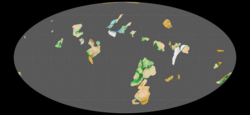Orosirian
| Orosirian | |||||||||||||||||
|---|---|---|---|---|---|---|---|---|---|---|---|---|---|---|---|---|---|
 A map of Earth as it appeared during the early Orosirian, c. 2 Ga[citation needed] | |||||||||||||||||
| Chronology | |||||||||||||||||
| |||||||||||||||||
| Etymology | |||||||||||||||||
| Name formality | Formal | ||||||||||||||||
| Usage information | |||||||||||||||||
| Celestial body | Earth | ||||||||||||||||
| Regional usage | Global (ICS) | ||||||||||||||||
| Time scale(s) used | ICS Time Scale | ||||||||||||||||
| Definition | |||||||||||||||||
| Chronological unit | Period | ||||||||||||||||
| Stratigraphic unit | System | ||||||||||||||||
| Time span formality | Formal | ||||||||||||||||
| Lower boundary definition | Defined chronometrically | ||||||||||||||||
| Lower GSSA ratified | 1991[1] | ||||||||||||||||
| Upper boundary definition | Defined chronometrically | ||||||||||||||||
| Upper GSSA ratified | 1991[1] | ||||||||||||||||
The Orosirian Period ( /ˌɒroʊˈsɪəriən/; Ancient Greek: ὀροσειρά, romanized: oroseirá, meaning "mountain range") is the third geologic period in the Paleoproterozoic Era and lasted from 2050 Mya to 1800 Mya (million years ago).[2] Instead of being based on stratigraphy, these dates are defined chronometrically.

The later half of the period was an episode of intensive orogeny on virtually all continents.
Two of the largest known impact events on Earth occurred during the Orosirian. Early in the period, 2023 Mya, a large asteroid collision created the Vredefort impact structure. The event that created the Sudbury Basin structure occurred near the end of the period, 1850 Mya.
For the time period from about 2060 to 1780 Mya, an alternative period based on stratigraphy rather than chronometry, named the Columbian, was suggested in the geological timescale review 2012 edited by Gradstein et al.,[3] but as of February 2022, this has not yet been officially adopted by the IUGS.
Paleogeography
The supercontinent Columbia formed at the end of this period.[citation needed]
References
- "Orosirian Period". GeoWhen Database. Retrieved July 8, 2011.
- James G. Ogg (2004). "Status on Divisions of the International Geologic Time Scale". Lethaia. 37 (2): 183–199. doi:10.1080/00241160410006492.
- ^ a b Plumb, K. A. (June 1, 1991). "New Precambrian time scale". Episodes. 14 (2): 139–140. doi:10.18814/epiiugs/1991/v14i2/005.
- ^ David Huddart; Tim Stott (16 April 2013). Earth Environments: Past, Present and Future. John Wiley & Sons. pp. 1599–. ISBN 978-1-118-68812-0.
- ^ Gradstein, F.M.; et al., eds. (2012). The Geologic Time Scale 2012. Vol. 1. Elsevier. pp. 361–365. ISBN 978-0-44-459390-0.
